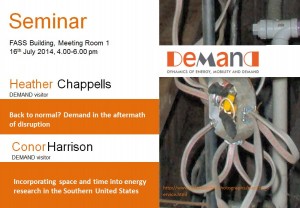 DEMAND Double Bill seminar from two DEMAND visitors:
DEMAND Double Bill seminar from two DEMAND visitors:
Heather’s talk focused on the relation between crisis and normality – in terms of energy demand. She introduced a catalogue of questions about this relationship. Some had to do with scale: there are obviously differences between ‘large’ and extensive crises – such as the 1970s oil crisis, and other much shorter term blips in supply, especially with respect to the duration of the effect and the ‘return’ to normality. In talking about what makes a crisis she noted that the terminology of disruption is itself loaded – it is not simply a means of talking about change in that it implies some kind of lurch or sudden challenge either in the practices on which energy demand depends, or in systems of provision (see also Sara Pasquier, IEA, Saving energy in a hurry). In this the idea of disruption is in contrast to notions of stability or resilience – though as we noticed it also takes ‘work’ to keep things the same.
Disruptions like the 1970s oil crisis take different form in different locations– in effect they have variable impact on what are in any case already diverse configurations of daily life. One big crisis can therefore be made of many different context specific ‘crises’. In thinking about this, issues of resilience are also relevant: how much localised flex is there in the ‘system’: clearly many systems/infrastructural arrangements cope with seasonal change, but what are the limits? As Heather noted, responses to disruption reflect expectations not just of what counts as normal (e.g. heating, cooling, lighting), but also expectations of how much ‘normal’ is expected to vary, and how much experience there is of coping with such variation.
We considered the value of dramatic disruption as a methodological ‘dip stick’: crises in the 1950s, 1970s, 2010s, etc. each ‘reveal’ different understandings of how daily life ‘should’ be under normal circumstances. Such moments, and series of them, potentially provide some clues as to which practices are shaken up, and which persist untouched.
Conor’s talk also dealt with issues of method, concentrating especially on the overlapping spatial scales of making and distributing electric power. He had some excellent maps plotting the exact locations in which electric light and power arrived, and showing that these spots mapped onto social and cultural divisions – in effect the richer white areas were electrified first.
As well as demonstrating the relation between social and electrical power, Conor introduced us to different methods for linking biographical and geographical data. See Stanford spatial history project: http://web.stanford.edu/group/spatialhistory/cgi-bin/site/index.php.
His discussion of the ‘arrival’ of electric power, and of the appliances required to use it prompted further thought about the ‘disruptive’ (to use Heather’s terms) effect of this transformation: what features of the pre-electrical era were cast aside, at what point did ‘electrification’ arrive in the lives of different practices, what skills were eroded, what old rhythms were abandoned?
Abstracts:
Heather Chappells, Department of Geography at Saint Mary’s University in Halifax, Nova Scotia, Canada
Back to normal? Demand in the aftermath of disruption
Abstract: Energy disruptions are usually short-lived events with power companies and consumers striving to resume to normal operations, services and routines. The purpose of this seminar is to explore whether disruptive events can also be seen to have a more enduring influence on energy systems, consumer practices and on the dynamics of demand. Preliminary analysis of materials documenting social and cultural responses to past heat wave events reveals both the normalization of new dependencies on air-conditioning as a way of dealing with disruption and the reliance on traditional low-tech coping strategies (e.g. ice, curtains, fans) as a way of seeing out the temporary inconvenience of occasional hot weather. Institutional and policy accounts of responses to temporary power shortfalls have further demarcated between proportionate approaches that harness consumer demand flexibility as a way to override crises and disproportionate ones that increase pressure for more supply capacity to meet occasional moments of abnormal demand. In the context of an evolving program of research on the dynamics of demand in the context of historical energy disruptions, several key questions will be explored. What exactly does it mean to return to normal service or practice in the aftermath of energy disruptions? What evidence is there that social or technological changes enacted during past disruptive events can become ‘locked in’ to have a sustained impact on energy demand? What evidence is there that harnessing consumer flexibility during disruption produces a sustained shift in energy habits or technologies? How do coping responses to disruption vary cross-culturally and with what consequences for the relative sustainability of demand trajectories? Finally, as anticipated climate change means disruption is set to become the “new normal”, I will consider debates about disruption as an opportunity for steering or accelerating transition to a low carbon society.
Conor Harrison, Department of Geography, University of South Carolina, USA
Incorporating space and time into energy research in the Southern United States
Abstract: What kind of research questions can we answer by researching patterns of energy consumption historically and geographically? What types of data are available, and how can we analyze it to inform issues of contemporary importance?
In this seminar I will focus on the development of electricity production, distribution, and consumption in North Carolina, USA by following the everyday practices of electric power politics and planning. Two cases will serve to question the common narrative used by historians of electricity to describe the take up of electricity – ‘if a household can afford electricity, it would begin using it’ – and instead show the shaping influence of geographic context and especially the issues of racism and white supremacy.

